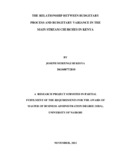| dc.description.abstract | A budget is a key management tool for planning, monitoring, and controlling the
finances of a project or organization. It estimates the income and expenditures for a set
period of time for any organization. The aim of this study was to examine the
relationship between budgetary process and budget variance in Kenyan mainstream
churches, the study adopted a research design that was descriptive survey in nature. The
target population for this study consisted of the mainstream Kenyan churches that
currently operate/don’t operate a budgetary process in their churches. The study
sampled 25 churches from the mainstream churches. The target respondents were
senior pastor(s), elders, church executive officials and administrative heads.
Quantitative method of analysis applied for the study. The filled questionnaires were
edited and coded according to the respective specific objectives of the study to ensure
accuracy and minimize on the margin of error. They were later entered into the
Statistical Package for Social Scientists (SPSS) for data processing and analysis. The
various measures of central tendency and dispersion were analyzed and used to
interpret and make inferences. The data was presented using tables, graphs and charts to
give the results of the findings.
The findings of the study revealed that a greater proportion (49%) of the mainstream
churches raise over Kshs. 500,000 from tithes and offerings within a month,30%
raise Kshs. 401-500,000 while only 4% obtain below Kshs.100,00.The findings
imply that the mainstream churches rely mostly on the tithes and offerings as their
main sources of income. Out of the churches targeted for the study, 41% raise Kshs.
101,000-200,000,20% raise Kshs. 301,000-400,000,only 6% raise over Kshs.500,000
from fundraisings. Among the targeted mainstream churches 54% take +/-10% as the
tolerance limits while 12% take +/-15% as the tolerance limits. The findings imply
that the churches budgetary controls are weak and this explain why a greater
proportion of the churches have put tolerance limits of above +/-5%. The findings of
the study reveal that budget planning, budget measurement report, budget monitoring
and actions taken for adverse budget variances have positive and significant
relationships with the budget variance. They were, respectively, at the significant
levels of 0.01, 0.1, and 0.05. | en_US |

